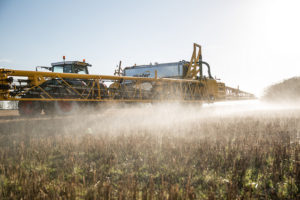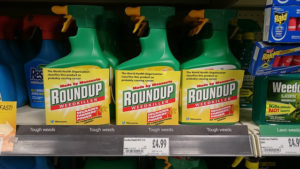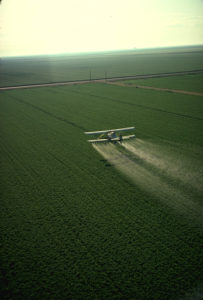Glyphosate is one of the most commonly used herbicides throughout agriculture and all over the world. It is considered a “non-selective” herbicide, meaning that it’ll kill most plants that come in contact with it. In a nutshell, it works by inhibiting specific enzymes in

Photo courtesy Flickr user Chafer Machinery
the shikimate pathway, which effectively prevents the plants’ ability to make the amino acids phenylalanine, tyrosine, and tryptophan, which are just some of the amino acids required to maintain life.
Despite this effectiveness, studies have shown that glyphosate application may have other indirect, undesirable consequences. Specifically, since glyphosate acts non-specifically, any plant that comes in contact with it is at risk. Studies have shown that while glyphosate is usually applied to the leaves, some of it can seep down into the soil and affect the health and mortality of other plants that were not meant to be targeted.
Additionally, studies have also shown that glyphosate exposure can have devastating consequences in humans (particularly when the exposure level is high), such as obesity, diabetes, cancer, cardiovascular disease, gastrointestinal problems, and Alzheimer’s. Since humans do not have the shikimate pathway, it is clear that there are other pathways that can be affected by glyphosate exposure.
In addition to the shikimate pathway, there are other ways glyphosate works as an effective herbicide. For one, it can form stable complexes with various cations in plants, which prevent these cations from functioning normally in the plant’s tissues. Also, glyphosate has been shown to decrease the availability of various nutrients in plants, which are ultimately required for healthy growth and development. Studies in sunflowers have shown that glyphosate exposure decreases seed production and decreases the quality of those seeds that are produced.
As far as a new study presented in the journal Food Chemistry is concerned, there have been no studies examining the indirect effects of glyphosate on the edible portions of

Photo courtesy Global Justice Now
plants (i.e. the fruits), specifically in regards to the fruits’ chemical composition. Along those same lines, the indirect effects of glyphosate application on the chemical composition of wine grapes has not been studied in the peer-reviewed literature, and considering that glyphosate is frequently used in viticulture management practices it would be of interest to know what, if any, indirect effects on the grapes (and ultimately wine) occur.
Therefore, the study presented today (Food Chemistry, June 2016) aimed to examine the effects of glyphosate application on the chemical composition (with inferences to quality) of the Ancellotta wine grape.
Brief Methods
The study vineyard was planted in 1994 and was located in Tebano, Ravenna, Italy.
Two soil treatments were performed and compared: 1) glyphosate application 3x during the growing season and 2) superficial (5-10cm) soil tillage 2x during the growing season.
Both treatments were applied to four replicates, with each replicate having two plants.
The different soil treatments were applied on every other row, with a large trench dug in between rows in an attempt to reduce or eliminate possible cross contamination of glyphosate into the soil tillage treatment rows.
Grapes were collected periodically throughout the season (between veraison and harvest) and tested for the following: berry weight, total soluble solids (i.e. Brix), titratable acidity, and pH. Anthocyanins were tested on grapes at the time of harvest.
Wine was made from the grapes in both soil treatments with the following measured and analyzed: phenolic acids, flavonoids, and anthocyanins. Four batches were created per soil treatment, with results represented as an average of these four.
Selected Results
- There were no differences in berry weight or total soluble solids between the two treatments.
- pH and titratable acidity levels were basically the same for each treatment up until the last sampling date at harvest
- At harvest, pH levels were lower and titratable acidity levels were higher in grapes from the superficial tillage treatment compared with grapes from the glyphosate treatment.
- Lower levels of 3’4’5’-OH (tri-hydroxylated anthocyanins) and 3’4’-OH(di-hydroxylated anthocyanins) were found in grapes in the glyphosate treatment compared with the soil tillage treatment.
- Some anthocyanins were found to be significantly lower in grapes from the glyphosate treatment compared with the soil tillage treatment (i.e. delphinidin-3-glucoside and peoidin-3-glucoside).
- There were no significant differences in the concentrations of the following anthocyanins regardless of soil treatment type: peonidin-3-O-(6”-acetylglucoside and malvidin3-O-(6”-acetylglucoside.
- In finished wines, there were no significant differences in anthocyanins and other polyphenol levels regardless of soil treatment type.
Conclusions
Overall, the results of this study would suggest that for some anthocyanins and other chemical compounds in grapes and wine, there doesn’t appear to be any negative (or positive, for that matter) influence of glyphosate exposure. On the other hand, the few anthocyanins that were affects showed a reduction in the levels of these compounds that

Photo courtesy theUnited States Department of Agriculture (Public Domain)
would otherwise be naturally occurring. Specifically, some anthocyanins were found to be lower in grapes that were treated with glyphosate, indicating that the wine color (and thus overall wine quality) MIGHT be affected by glyphosate exposure.
Interestingly, when the researchers looked at the finished wine made from these grapes, they did not see the differences in chemical composition that they originally saw in the grapes prior to winemaking. In other words, the chemical make-up of the grapes seems to be affected (at least somewhat) by glyphosate, whereas the wines made from these grapes do not seem to show a difference when compared to the soil tillage treatment.
Since this is the first study of its kind (according to the researchers, anyway), there is obviously a lot of work that needs to be done to further understand the effects of glyphosate exposure on the chemical composition and thus quality of wines. From this first study, it appears as though glyphosate exposure does affect the chemical composition of the grapes themselves; however that does not seem to be the case for the finished wines. It would be interesting to see a follow-up study that might get to the bottom of these discrepancies, as well as a study that looks at more than one grape variety.
I realize there are a lot of other potential issues surrounding glyphosate and wine, particularly in regards to the question of whether or not the herbicide is actually found IN wines itself, but that was not within the scope of this particular research article so I won’t touch on that subject for now.
If glyphosate does, in fact, change the chemical composition of wine grapes to the point where overall quality is reduced, it might be worth considering its’ continued use. When you take into consideration all of the other controversies surrounding the herbicide, it may become that much more difficult to justify the use of the product any further.
What do you all think of this study? What sort of follow-up study would you like to see? Feel free to share your thoughts/questions by leaving your comments!
Source:

8 comments for “The Effect of Glyphosate on the Chemical Composition of Grapes and Wine: Implications for Grape and Wine Quality”